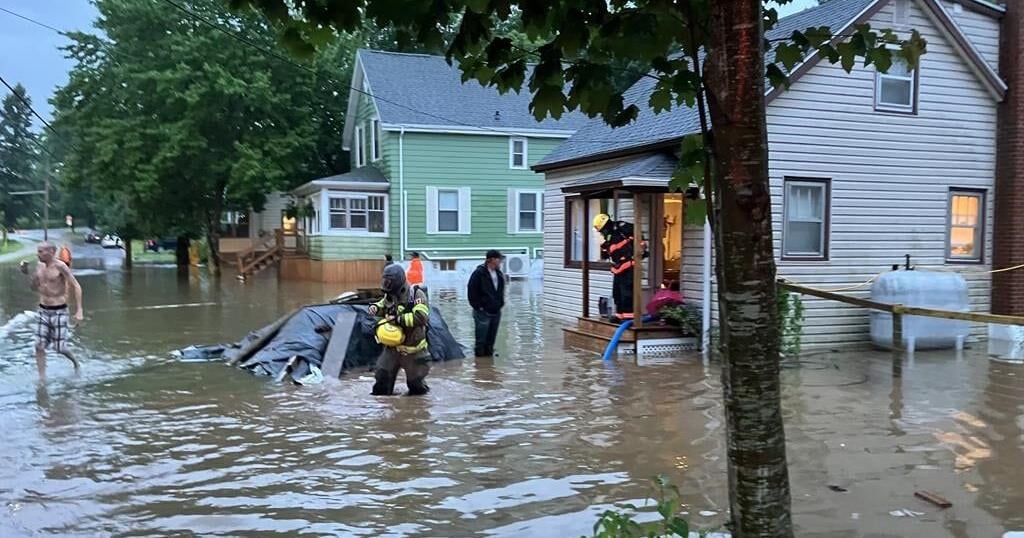WOLFVILLE, N.S. – The second bout of deadly flooding in as many years has some Nova Scotia residents and municipal leaders saying it’s time for the provincial government to accept that extreme weather is the new normal and make sure people have the tools they need to stay safe.
In Kings County, Coun. Dick Killam said the provincial government denied funding to his community twice in the past four years that would have led to work that would have shored up his community better to withstand Thursday’s torrential rains.
And the first-ever manager of the Canadian Hurricane Centre said it’s well past time for Nova Scotia to built a robust prediction, detection and alert system for flash flooding.
“The system makes it really difficult to provide advance warning,” said Jim Abraham, who is also a retired Environment Canada meteorologist. “If the province, who’s responsible for flood warnings or alerting, doesn’t have the infrastructure to detect and predict — if there isn’t even such an official thing as a flood warning program — then, of course, it’s going to take longer.”
The tail end of hurricane Beryl doused parts of western and central Nova Scotia with more than 100 millimetres of rain in just a few hours on Thursday. Roads and homes were flooded across an area stretching from Digby to Guysborough, Environment Canada said.
A young person died after they were swept into a ditch overflowing with rushing floodwaters in Wolfville, about 95 kilometres northeast of Halifax. RCMP said they got a call about the youth disappearing under the rushing water at about 7:30 p.m.
The province’s Emergency Management Office issued flash flood alerts in four counties about an hour later. The alerts did not ask people to shelter in place.
In July last year, four people died — including two young children — in floods in the nearby municipality of West Hants after 250 mm of rain fell over 24 hours.
Recordings of radio calls made Thursday evening by the fire department Kings County, which includes Wolfville, indicate that residents were already calling in about extreme flooding around 5:30 p.m. The calls were first reported by the Globe and Mail and described submerged, impassable roads and people having to flee their homes.
If the province had a well-developed flooding alert system, emergency notices likely would have been sent to people’s phones before a tragedy had already happened, Abraham said in an interview. And they would have asked people to shelter in place.
Such a system, he added, would also involve public education that would inform people in areas prone to flash floods about the risks, as well as which parts of their neighborhoods are especially dangerous.
Though the federal weather system issues warnings about severe weather that causes floods, provinces are responsible for any kind of flood predicting programs and warnings, Abraham said. Nova Scotia uses a provincial Emergency Management Office to gather information and issue warnings, and it gets most of its information from fire fighters and police working on the ground in emergencies, he said.
They’re extremely hardworking and knowledgeable, he said, but they’re not hydrologists or meteorologists.
“As much as I can tell, by the time … the impact of the event is recognized, it’s already almost too late to get the alert out,” he said. “And in this case the event had mostly passed by the time the alert went out.”
He said the province should start working with the federal government to combine resources and develop a full flash flood program. When asked if government should have started this work after last year’s floods, Abraham was unequivocal: “Yes.”
The provincial Emergency Management Office did not respond to a request for comment.
In Halls Harbour, a small community on the Bay of Fundy, pictures posted to social media showed part of the community’s U-shaped road had collapsed into the sea. The road appeared to be split in two and impassable.
Killam said he applied three times for special funding from the provincial government for money that would help the town shore up its failing sea wall and wharf. The money would have also gone to reinforcement work on the part of the road that sits out over the water. If that work had been done, the damage wrought by Thursday’s storm may not have been so severe, Killam said in an interview.
He said his first two applications were denied, and he’s still waiting to hear back about the third. But after Thursday, that money seems more urgent than ever, he said.
“They were saying, ‘Well, you know, climate change, in the future.’ Well, as I’ve said before, the future’s here now, and we’re in for some major problems,” Killam said.
This report by The Canadian Press was first published July 13, 2024.
— Written by Sarah Smellie in St. John’s, N.L.
